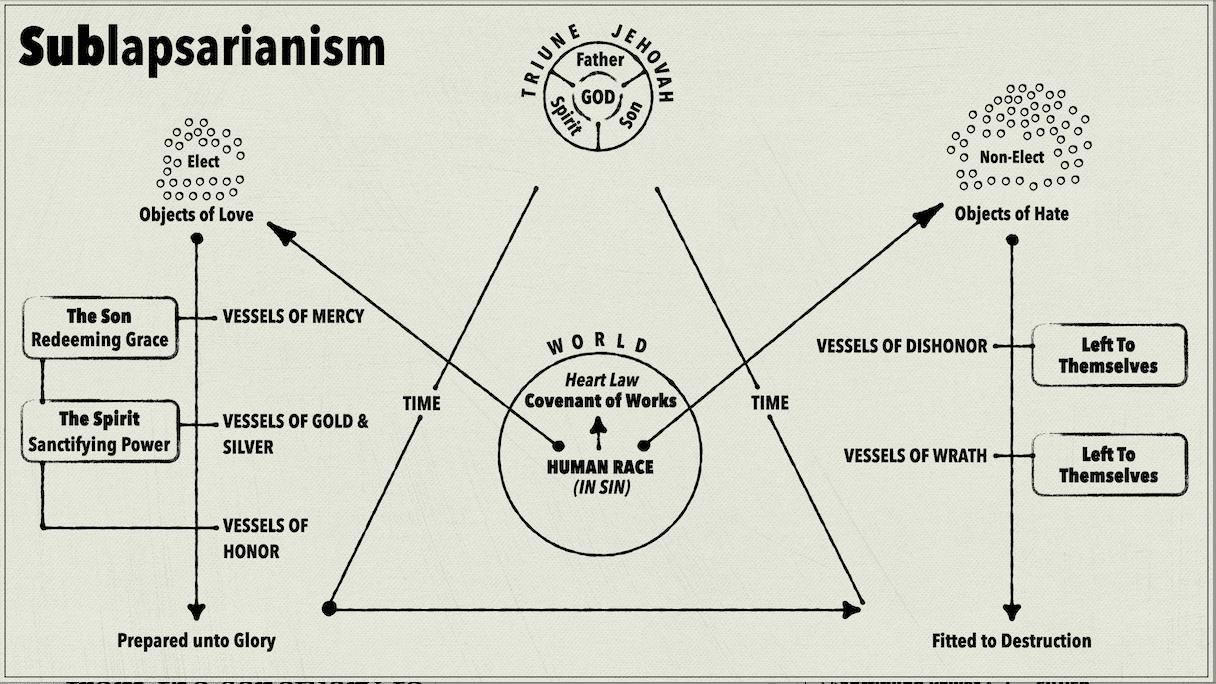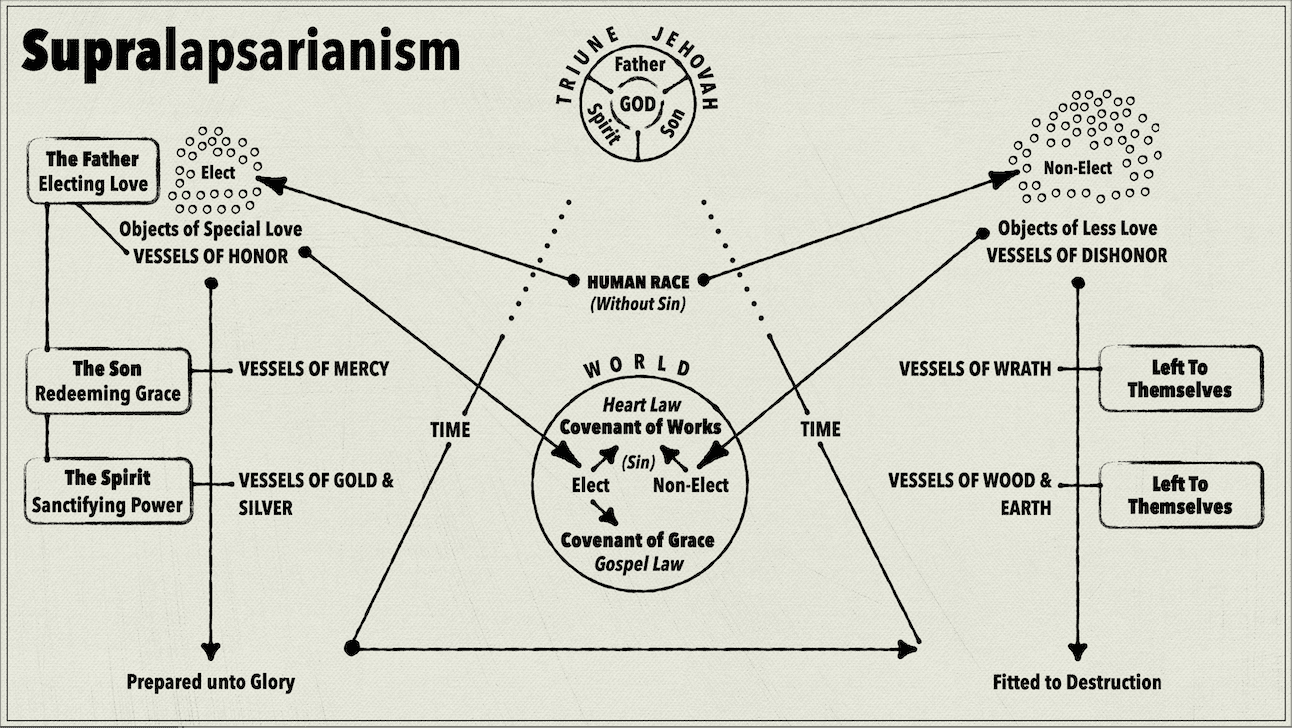20 Bible Doctrine – What Does Lapsarianism Mean?
A Transcript Of The Video Study
In our previous study, I held forth, what is sometimes called, the Supralapsarian view of the Father’s electing love. For this study, I would like to speak on this subject at more length. If we remove the prefix of the word, then we are left with lapsarian. The Latin term “lapsus” means “to fall”, from which we get our English word lapse, referring to a fall or failure to maintain some standard. For instance, you might say, “I had a lapse in memory.” Or, “I lapsed behind when I went for a walk with my family.” Well, when the label Lapsarianism is used in a theological context, it is speaking about the decree of God in election as it relates to the Fall of Adam. Did God decree election before or after the Fall of Adam? To answer this question, I would like arrange my thoughts under three headings:
1. What Are The Leading Views Of Lapsarianism?
2. How Do These Views Line Up Side By Side?
3. What Do These Views Look Like When Diagramed?
Let’s begin with the first of these headings:
1. What Are The Leading Views Of Lapsarianism?
There are three prefixes to the label which represent the variant views on the order of God’s decree of election—supra, sub and infra. The prefix supra means “above, or before”, with lapsus, “the fall”—God decreed the election of His people before decreeing the fall; the prefix sub means “under”, with lapsus, “the fall”—God decreed the election of His people after decreeing the fall; the prefix infra means “below, or after”, with lapsus, “the fall”—God decreed the election of His people after decreeing the fall. Henceforth, Supralapsarianism refers to God viewing the human race without sin when electing some as objects of His special love; whereas Sublapsarianism and Infralapsarianism refer to God viewing the human race in sin when electing some as objects of His special love. Now, technically speaking, some will distinguish between Sublapsarianism and Infralapsarainism, but for the purpose of this study, I use the terms interchangeably as both labels represent the same general view, namely, that God elected a people to Himself after decreeing the Fall, and therefore viewing them in sin. Whereas Supralapsarianism represents the view that God elected a people to Himself before decreeing the Fall, therefore initially viewing them without sin. In a nutshell, these are the leading issues involved when we speak on the subject of Lapsarianism. We are dealing with the order of God’s decree of election as it relates to the Fall of Adam.
“But wait a minute,” you say, “Hasn’t God chosen His people before the foundation of the world? Doesn’t that solve this whole question of the order of God’s decree? I mean, if God elected His people before the world began, then His choice must have preceded the Fall of Adam.” Well, you certainly make a valid point—God has chosen His people before the foundation of the world. However, this does not solve the question on the order in which God has decreed election from eternity. You see, when we speak about the Lapsarian issue, we are not talking about the chronological order of God’s decree as it comes to pass in time, but rather, the logical order of His decree as it is determined by Him from eternity. With reference to the chronological order, those on both sides of the Lapsarian issue agree that God has elected a people unto salvation before the foundation of the world. The chronological order of God’s electing love is not in dispute. That which is in dispute relates entirely to the logical order in which God set out His eternal decree, before bringing time and creation into existence. Let me explain it this way. The logical order of God’s eternal decree is to time and creation, what the blueprint is for a house. The blueprint is not the actual house, it is only a plan or image of what that house will be. And so is the decree of God for time and creation. The eternal decree is not the actual creation and events coming to pass in time, but only the plan or blueprint of what creation and those events will look like. In other words, the decree of God is His masterplan for the ages, insomuch that everything which is brought into existence and comes to pass in time is the actualization of everything God has ordained, planned or decreed from eternity. And, you see, it is within the context of God’s eternal blueprint that we are asking this Lapsarian question: In what order has God decreed the election of His people—was it before He decreed the Fall, or after He decreed the Fall?
So, these are the leading views of Lapsarianism. Let us now turn to the second heading:
2. How Do These Leading Views Line Up Side By Side?
In order to better understand Lapsarianism, I would like to distinguish between the views by presenting them side by side for easy comparison.
First, let’s consider the order of God’s decree of election according to the Sublapsarian framework. God has decreed (1) to create all things; (2) to permit the Fall of the human race; (3) to elect in Christ some to salvation, devising the plans of redemption and regeneration; (4) to leave the others to their just condemnation. Now, most Moderate-Calvinists hold to this view, as do some Hyper-Calvinists. They understand election to be inseparably linked to Christ, often quoting from Ephesians 1:4: “According as [the Father] hath chosen us in [Christ] before the foundation of the world…”. They cannot even conceive the possibility that the Father has chosen a people to Himself, before putting them “in Christ”, or before giving them to Christ.
However, although this view is held by Moderate and Hyper Calvinists, they do not agree with each other on every point. For instance, the Moderate-Calvinists insert into this scheme the duty of sinners to savingly believe on Christ. Let me show you want I mean by singling out the three branches of the gospel—election, redemption and regeneration.
With regards to election, the Moderate-Calvinists appear to be one with the High-Calvinists, believing that election is not conditioned upon the saving faith of sinners. However, with reference to redemption, Moderate-Calvinists certainly do believe saving faith is a condition upon which Christ redeems His people from their sins. They hang conditional redemption on the peg of God’s infinity, arguing that there is an infinite virtue in Christ’s atoning blood sufficient to save all sinners if only they will avail themselves of it by believing on Christ to the saving of their souls. This is the teaching of an 18th century Baptist theologian named Andrew Fuller, and make no mistake, all Moderate-Calvinists subscribe to this teaching in one form or another. In so doing, the Moderate-Calvinists subscribe to particular redemption on the one hand, insomuch that only those who believe are recipients of its blessings, while subscribing to universal atonement on the other hand, insomuch that there is a sufficiency in Christ’s blood to atone for the sins of the whole world. Henceforth, Moderate-Calvinists believe in conditional redemption. With reference to regeneration, they also insist that saving faith is a condition upon which the Spirit of God regenerates the soul. On the one hand, they will deny that saving faith is a condition for the New Birth, asserting that regeneration is by the effectual power of the Spirit of God alone. On the other hand, they will insist that saving faith is a condition for the New Birth, asserting that while God is sovereign, man is responsible, and therefore saving faith is the sinner’s moral duty.
Now, just in case you raise an eyebrow at these contradictions, wondering how the Moderate-Calvinist navigates around them, they actually have a very simple answer. They will tell you that these contradictions are by divine origin—they may be contradictions to us, but they are not contradictions to Him, and therefore we must accept them as truth, even though they appear to be incompatible teachings. Of course, most of us test truth claims according to the Law of Non-contradiction, but not so with the Moderate-Calvinists. When it comes to the gospel, they believe truth must be tested according to the Law of Contradiction. And so, Moderate-Calvinists will insert into the Sublapsarian scheme of God’s decree the duty of sinners to savingly believe on Christ, thereby making redemption and regeneration conditional upon the sinner’s faith. The Hyper-Calvinists, on the other hand, outright reject saving faith as a duty or condition for salvation, believing it is a gift. You see, the Hyper-Calvinists believe the conditions for salvation belong to the three persons of the Godhead who have agreed to save their people from their sins—the Father choosing them, the Son redeeming them and the Spirit sanctifying them. The terms of the covenant of grace are fulfilled by the Father, the Son and the Spirit on behalf of elect sinners. It is in this way that a Hyper-Calvinist may subscribe to the framework of Sublapsarainism, yet still maintain a high view of sovereign grace.
Second, let me set out the order of God’s decree of election according to the Supralapsarian framework. God has decreed (1) to elect some as objects of special love, setting aside the others as objects of less love—at this point in the decree, sin is not in view, nor is the grace or wrath of God manifested; (2) to create all things; (3) to arrange the Fall of the human race; (4) to leave the objects of less love in their sins, fitted to destruction; (5) to save the elect from their sins by devising the plans of redemption and regeneration. As you can see, the order of God’s decree of election is quite different from the Sublapsarian framework. In essence, the Sublapsarians believe God viewed the human race after it fell in sin, out from which He elected a people in Christ; whereas the Supralapsarians believe God viewed the human race before it fell in sin, out from which He elected a people before giving them to Christ. Now, there may be a few Moderate-Calvinists who subscribe to Supralapsarianism, but if they do, they make the same mistake by inserting into the scheme the duty of sinners to savingly believe on Christ. However, it is safe to say, the majority of those who subscribe to Supralapsarianism are Hyper-Calvinists, who flat out reject saving faith as a duty or condition for salvation.
So, this is how the Lapsarain views line up side by side. This then brings us to the third heading:
3. What Do These Leading Views Look Like When Diagramed?
Let’s begin with the Sublapsarian framework.
We start with the TriUne Jehovah. First, He chooses to bring into existence time and creation. Second, He establishes with Adam a covenant of works. Third, He appoints Adam to serve as the covenant head for the human race. Fourth, He permits Adam to sin, plunging the entire human race into sin and judgment. Fifth, He chooses some sinners as special objects of His love, appointing Christ to serve as their Redeemer, and the Holy Spirit as their Sanctifier. Now, it is important to note, if the Father set apart His elect people as objects of His special love while viewing them in sin, they were not at that point vessels of honor, for they are viewed in sin. Henceforth, according to the Sublapsarian framework, God’s elect people are made vessels of honor only after they are made vessels of mercy and vessels of gold and silver. It is in this way, according to the Sublapsarian framework of divine election, that God’s elect people are prepared unto glory. Sixth, God leaves the other members of the human race in their sins, they having made themselves vessels of dishonor by their sins, and therefore made by God the vessels of wrath, fitted to destruction. In a nutshell, this is the Sublapsarian framework of God’s decree of election. And, as I have said, the majority of Moderate-Calvinists and not a few Hyper-Calvinists hold to this view.
Let’s now look at the Supralapsarian framework.
We begin with the TriUne Jehovah. First, God the Father envisions the whole mass of the human race, without considering them in sin, choosing to set some apart as objects of His special love, making them vessels unto honor, while setting aside the others as objects of less love, making them vessels unto dishonor. Second, He determines how He will bring the human race into existence—they will be brought under the restraints of a time continuum and placed in a purpose built world. Third, He establishes with Adam a covenant of works, appointing him to serve as the covenant head for the entire human race; Fourth, He arranges the Fall of Adam, in consequence of which the entire human race is plunged into sin and condemnation; Fifth, He leaves the objects of less love to themselves, in their sins, making them vessels of wrath and vessels of wood and earth, fitting them to destruction; Sixth, Because the Father has already set His love upon His elect people, He devises a twofold plan of salvation to deliver the objects of His special love from their sins: (1) The elect are given to the Son (hence, they are chosen in Christ), Who is appointed by the Father to serve as their Mediator and Redeemer; (2) The elect are given to the Holy Spirit, Who is appointed by the Father and the Son to serve as their Sanctifier (beginning with the work of regeneration). It is in this way, the elect are prepared unto glory, according to the three branches of the gospel, which is none other than the gracious covenant of the TriUne Jehovah, designed for and promised only to God’s elect. In a nutshell, this is the Supralapsarian framework of God’s decree of election.
Now, I do not know of any Moderate-Calvinists who subscribe to this exact view, as I have laid it out in this diagram. Nor are there many Hyper-Calvinists who subscribe to it. However, this is the view I believe is aligned with the teachings of scripture and is the only view consistent with the three branches of the gracious covenant. Having said this, I wonder, how well have you followed the teachings I have given to you in this study? Have you been able to understand the difference between the chronological order of God’s decree in time and the logical order of His decree from eternity? Have you been able to understand the order of God’s decree according to the Sublapsarian framework? Have you been able to understand the order of God’s decree according to the Supralapsarian framework? If this is your first time to hear of these things, then I suspect you are pretty overwhelmed at this point. That is to be expected. You need time to process the teachings. Of course, you can always make use of this video study by reviewing the teachings as many times as you need.
For our next study, I will share with you the reasons I believe God’s decree of election is aligned with the Supralapsarian framework. Until then, I hope you will make the time to review the teachings of this study. May you know the Lord’s blessing as you continue to grow in grace and in a knowledge of the Lord Jesus Christ.
Jared Smith served twenty years as pastor of a Strict and Particular Baptist church in Kensington (London, England). He now serves as an Evangelist in the Philippines, preaching the gospel, organizing churches and training gospel preachers.
Jared Smith on Eldership
Jared Smith on the Biblical Covenants
Jared Smith on the Gospel Law
Jared Smith on the Gospel Message
Jared Smith on Various Issues
Jared Smith, Covenant Baptist Church, Philippines
Jared Smith on Bible Doctrine
Jared Smith on Bible Reading
Jared Smith's Studies in Romans
Jared Smith's Hymn Studies
Jared Smith's Maternal Ancestry (Complete)
Jared Smith's Sermons






